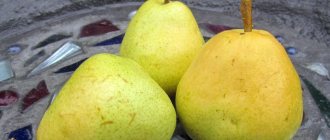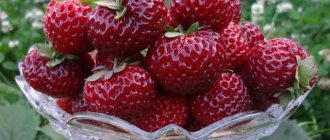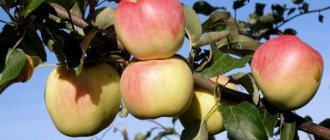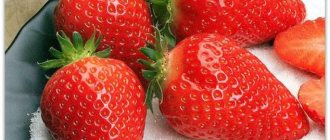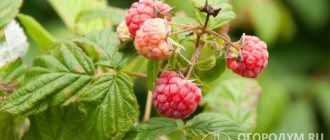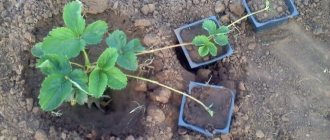White strawberry
Strawberries are not a special crop in the garden beds of our summer residents; they are not uncommon and many people grow them. But not everyone can boast of white strawberries. In our article we will talk about this unusual berry, and also tell you about popular varieties and the rules for growing white strawberries.
History of selection
This unusual berry appeared in Europe about three hundred years ago. The history of this phenomenon became known after the selection of several species of wild strawberries growing in America - Chilean and Virginia.
Despite the uniqueness of this berry, by the beginning of our century, white strawberries had almost disappeared. And then a group of Dutch farmers decided that they should not allow this to happen, and not so long ago they recreated the American strawberry hybrid again.
Reviews from summer residents
New varieties of garden strawberries have recently appeared among domestic amateur gardeners. But these pioneers point to white-berry strawberries as very promising. For example, the White Swede variety winters well even in the Tyumen region.
Summer residents also like the fact that rare strawberries are no different in care from ordinary varieties, tolerate dry summers well, and produce a good harvest with minimal watering. Its berries are very tasty, sweet, and kids adore them. For propagation of white strawberries, rooting the tendrils in small plastic containers and then separating them from the mother bush is well suited.
Why are strawberries white?
Initially, you need to figure out why the strawberries we are used to are red. It has a green color at the initial stage of its maturation.
However, subsequently a special pigment appears, coloring it red. White strawberries partially or completely lack this pigment, so they remain white. This is the peculiarity of this berry.
Where is the best place to grow
White strawberries can be grown both in the garden and in the greenhouse. Very small varieties can be sown at home. White-fruited berries also take root in shaded areas. A prerequisite for full ripening is timely, abundant watering during flowering. Excess water is not desirable, but is allowed. The taste and juiciness do not change.
The most fertile place is the soil where legumes, cereals or corn grew. You cannot plant berries in the place of raspberries, cucumber, tomato beds, or potatoes. The soil under such crops is not suitable for fruit ripening.
Before planting seedlings, the soil is cleared of debris: dirt, weeds and last year’s rhizomes.
Differences and main advantage of white strawberries
At first glance, white and red strawberries differ only in color, but this is not at all the case.
Despite the fact that strawberries with white fruits are not yet so popular among most farmers and gardeners, they can boast several irreplaceable qualities.
As we have already discussed, unusual white fruits are a consequence of the absence of the pigment responsible for the red color. Oddly enough, it is precisely because of this that many people are allergic to strawberries, so the lack of pigment in the “white” variety has become a godsend for allergy sufferers who love this summer berry.
The second equally important advantage is the ability to grow it in an environmentally friendly form, without using chemicals.
And the main thing is the excellent taste and aroma of this unique berry.
Reproduction
Since the white-fruited berry is a hybrid variety, it cannot be grown from seeds. The culture is propagated by means of a mustache. For rooting, choose the first spring tendril, which is considered the strongest. It is attached to the ground with a staple, and after 2-3 weeks it takes root.
Subsequently, the whiskers that appear on the adult plant during the year are removed at the bottom. The top ones are left as they lay buds for the next year.
Important! How to properly grow strawberries
White Swan
The White Swan variety first appeared in Japan. It is remontant, which means the plants are able to bear fruit repeatedly, or even repeatedly.
And also one of its main advantages is high yield. The variety has bushes 15-20 cm high and medium-sized snow-white fruits. The weight of the berry varies from 2.5 to 4 g and tastes like linden honey.
Further care
After planting, caring for strawberries consists of watering, fertilizing, trimming the tendrils and mulching. Since the crop loves moist soil, the soil under the bushes should not dry out. But stagnation of moisture should not be allowed.
When cared for, manure fertilizers and weed infusions have a good effect on productivity. The first feeding is carried out before flowering, the second - when flowers appear, then the soil is fertilized after fruiting, when the bushes lay buds for the next year. It is allowed to use mineral preparations, for example, nitroammophoska with equal amounts of nitrogen, potassium and phosphorus. Fertilizing of remontant species is carried out between harvests.
To keep the soil saturated with nutrients, weeds are regularly weeded under the bushes. To reduce their numbers, mulch with straw, pine needles or oak sawdust in a layer of up to 10 cm. Mulch protects the berries from dirt, slugs and ground insects.
Harvesting is carried out as the fruits ripen. They can be stored for up to 1 week, but the timing largely depends on the selected variety, growing conditions of the crop, and the presence of pests on the site.
Yellow miracle
But such a variety as the yellow miracle originated in another country - Holland. It is remontant, has larger bushes, the height of which reaches 20-25 cm. The berries are medium in size, weighing 4-5 g and have a yellowish color and a sweet taste.
Preparing strawberries for winter
How to use potassium humate for strawberries: using fertilizer for the garden. Composition, instructions for use and application methods (115 photos + video)
Strawberry Roxana - 85 photos, description, reviews, planting and growing a productive variety
Diseases, pests
The most common disease of white strawberries is gray rot, which looks like a gray coating on various parts of the bush. The disease develops in unstable weather, high humidity, and frequent precipitation. The fungal disease is transmitted by spores. The plant can be cured by removing all diseased bushes and leaves.
For preventive purposes, before flowering begins, the bushes are treated with an iodized solution. Dissolve 10 drops of iodine in 10 liters of water and irrigate the entire strawberry plantation with this liquid.
Timely prevention helps prevent the appearance of dangerous pests such as nematodes, weevils, spider mites, and mole crickets. Almost all varieties are not susceptible to diseases, and the pale color of the berries does not attract birds. Proper care, timely mulching, regular watering, as well as the removal of weeds and rotting shoots guarantee the safety of the berries throughout the entire fruiting period.
White strawberries are a berry that many gardeners don’t even know exists. But those who once planted this culture, delicious in taste and aroma, on their plot do not remain indifferent. Caring for white strawberries does not require much effort or money. The unpretentiousness of the white-fruited beauty attracts an increasing number of lovers of strawberry crops.
Pineberry
The name Pineberry is usually applied to all varieties that have white fruit. These strawberries are pineapple-flavored and have the same distinctive aroma.
Pineberry has many different names: White Dream, Pineapple, White Pineapple and so on. This Dutch variety is low-yielding, but unpretentious. Good disease resistance. It has compact bushes reaching 20-25 cm. In height and small fruits weighing from 1.5 to 2.5 grams.
However, its main feature is the taste of pineapple, as well as white berries with bright red seeds.
General characteristics of white-fruited garden strawberries
What is the phenomenon of white strawberries? A special protein, Fra a1 (Fragaria allergen 1), is responsible for the coloring of the familiar red varieties of strawberries. Thanks to numerous studies of this berry, it has been found that it is this “dye” protein that sometimes causes allergic reactions to it.
White strawberries differ genetically from strawberries with red berries only in the absence of the above component. Its unripe (green) fruits become white when ripe. True, on some of their varieties, due to the insignificant presence of coloring protein, a subtle blush appears, which greatly decorates them.
It is the absence of this component in these varieties of garden strawberries that makes them not only unique in color, but also completely safe for people suffering from rare types of allergies.
The berries of white-fruited garden strawberries are smaller than those of red-fruited ones. The only exception is the White Swede variety, the fruits of which weigh up to 25 grams or even more.
Their color can be snow-white, cream-white, white-yellow. In many ways, this impression is created by the color of the ripened seeds with which the berries are strewn. They can be bright red (“Pineberry”, “White Swede”, “Anablanca”) or yellow (“White Swan”, “Yellow Miracle”). The shape of the fruit also varies - conical, oblong, round.
The taste of these berries is unusual, delicate, combining various notes of wild strawberries, pineapple, mulberry and even linden honey. They can be both sweet and slightly sour, combining a whole range of different flavors. Due to the fact that these fruits are very delicate, they cannot be transported over long distances or stored for a long time.
The bushes of this strawberry are mostly compact, which makes it possible to grow them even in small areas. True, the yield of some varieties is low, and the berries are very small (“Pineberry”). But they are famous for their unpretentiousness and rare aroma and taste.
Varietal range
White Swede
The largest 40-gram berries are from the White Swede, bred in Sweden. The ripening period of conical fruits is average. The taste is sweet and sour and has a pleasant characteristic aroma. Mustaches in small quantities.
Tolerates drought, cold and fluctuating temperatures well. The plant is no longer susceptible to fungal diseases.
White Swan
Japanese White Swan has a dessert taste reminiscent of linden honey. The variety is remontant, high-yielding and beardless. The low bush is strewn with small snow-white elongated berries.
White Lotus
It is very similar to the previous variety White Lotus, but its yield is lower, the berries are smaller and not so white.
White miracle
With the Dutch remontant White miracle, a harvest is obtained in a temperate climate. The bushes are spreading, on average 22 cm tall. The berry is elongated, 4-5 grams each.
The taste is sweet and delicate aroma, the color of a ripe banana. Winter hardiness is average, but good immunity to disease and insect damage.
Anablanca
Anablanca can rarely be found, as it is a new French variety, but has already gained popularity. The berries are white or pinkish, up to 8 g, with pineapple flavor.
More on the topic: The most popular strawberry variety is Elsanta
The plantings are compacted and resistant to various viral and fungal infections, which makes it possible not to use chemicals. Repeated fruiting is possible.
Anablanca
The white strawberry variety Anablanca was recently developed. It is rare to find it on sale. However, if this happens, do not pass by under any circumstances. The variety was bred in France. It is characterized by exclusively white or slightly pink berries weighing 5-8 g. Pineapple notes are clearly visible in their aroma and taste.
Anablanca is highly resistant to diseases, and this makes it suitable for so-called eco-growing, i.e. without the use of chemicals.
The plant forms compact bushes; compacted planting can be used. In warm autumns, the variety has a tendency to bear fruit again.
Features of agricultural technology
White-fruited varieties do not have any special requirements for growing conditions. Just like ordinary garden strawberries, they love prepared air- and water-permeable soil, regular watering and respond well to fertilizing. They reproduce either by mustaches, or, if these are without mustache varieties, by seeds. They grow and bear fruit in one place for no more than 3 years, then the yield drops.
It is better to allocate the sunniest place for white-fruited varieties. Despite the more compact bush, the plantings should not be thickened - good lighting and ventilation will allow the plants to develop better and prevent the development of rot, to which this delicate berry is prone. The planting pattern should be 25–30 cm between bushes and 30–45 cm between rows.
If the strawberries are barren, they can be planted as a border plant - the bushes will decorate the flower garden with constant flowering, and at the same time delight with the harvest. The bush of white-fruited strawberries is larger than that of ordinary strawberries, and every year it grows more and more horns. For this reason, it is good to leave a distance of about 30–35 cm between plants.
Such strawberries can easily be propagated by self-sowing, so it is enough to grow them once from seeds that are sown in February-March, and then simply plant young plants that have sprouted from the seeds of berries that have fallen to the ground in a new place. Such strawberries bloom and bear fruit already in the first year of planting and until frost.
Application of fruits
If the year has been fruitful, and you are pretty tired of eating berries raw, make jam or compote for the winter.
Jam recipe
Required ingredients: 1 kg of strawberries, 1.5 kg of sugar, 1 g of citric acid.
Cooking process:
- We sort through the berries, getting rid of debris and leaves.
- Place in a colander, rinse and leave for 5 minutes. During this time, all excess water should drain.
- We select a pan of suitable capacity and place the strawberries there. This must be done in layers, alternating with sugar.
- Cover the pan tightly with a lid and leave for 5 hours.
- Place our container on the stove over low heat and bring to a boil. Don't forget to stir with a wooden spatula.
- Remove the formed foam.
- Cook for 20 minutes without increasing the heat.
- Then remove the lid and wrap it with a towel. This manipulation will get rid of excess moisture.
- Close the pan again with the same lid and leave the resulting mass until it cools completely.
- Boil the jam again.
- Add citric acid and mix thoroughly.
- Pour the jam into sterilized jars and close the lids.


